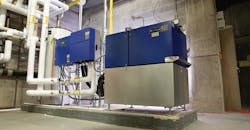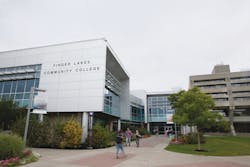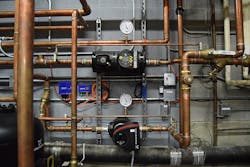Cogeneration Helps Meet Sustainability Goals
The main campus of Finger Lakes Community College is nestled at the northern tip of Canandaigua Lake, one of 11 lakes in New York’s Finger Lakes region. The college serves nearly 6,000 students at four campuses. It falls under the jurisdiction of the State University of New York, which includes 64 four-year and two-year schools. SUNY’s sustainability strategic plan includes benchmarks for water conservation, energy efficiency, food system sustainability and green infrastructure.
Energy-efficiency initiatives include Energy Smart New York, which calls for a 30 percent reduction in SUNY’s energy consumption by the end of this year; Build Smart New York, which is Gov. Andrew Cuomo’s initiative to reduce energy consumption by 20 percent at state agencies; and Brownfield to Brightfield, a pilot project to explore using renewable energy on EPA brownfield sites.
When FLCC’s Director of Facilities and Grounds Cathy Ahern came to the college in 2014, her priority was to look at how the existing mechanical systems were working and get a better baseload before starting any alternative energy projects on campus.
“The first thing everybody wants to do is see solar panels and wind turbines all over campus; they think it’s really cool,” she says. “But I pushed to start the energy reduction program by first looking at our older existing mechanical equipment and replacing with higher-efficiency equipment if needed.”
To that end, Ahern partnered with Bill Coe, director of project development for Rochester, N.Y.-based design-build mechanical contractor EMCOR Services Betlem. They began an energy conservation study, partially funded by the New York State Energy Research and Development Authority (NYSERDA), to identify capital projects to improve FLCC’s energy efficiency.
This in-depth look at campus mechanical equipment resulted in a list of about 20 energy conservation measures, Ahern notes, that were then prioritized. “You select the top 10 and start getting funding for them,” she says. “It’s like an energy master plan, if you will.”
Replacement of the outdated water heating system consisting of two Lochinvar boilers installed more than 25 years ago and a large hot water storage tank was the first and only project to date to get funded. A discussion of other projects was put on hold once the COVID-19 virus hit campus.
Ahern, who is a mechanical engineer and has more than 30 year’s HVAC and plumbing experience, knew the old boilers had to go. She intended only to replace the boilers with higher-efficiency models. But after talking with Coe and visiting Lochinvar, she was committed to using the hydronic heating manufacturer’s micro combined heating and power (CHP) system to supplement the campus’ water-heating system.
“There are quite a few reasons this made sense, the No. 1 reason being that, with the micro CHP, FLCC was able to produce electricity effectively at the same time it made domestic hot water for the campus,” Coe explains. “The second reason was the size; it’s not like the typical, larger CHP system. The size of the micro-CHP system matched the need for the domestic hot water demand quite well.”
In addition, the micro CHP offers supplemental space heating, which Coe acknowledges was a challenge to design.
“Coming up with a design and operational strategy allowing the micro CHP system to produce not only domestic hot water but also space-heating water across a couple of different hot water systems was a unique challenge,” he recalls. “It made the design more complex than a typical boiler system or a typical micro CHP system, but with the additional functionality, we’re able to maximize the output of the micro CHP.”
How does CHP work?
A combined heat and power system involves cogeneration, a process whereby one fuel source, such as natural gas, is burned in an internal combustion engine, producing heat while turning a generator and creating electricity.
“The benefit is that there is minimal waste,” explains Tommy Olson, a market segment manager at Lochinvar with more than 30 years in the hydronic heating industry. “Cogeneration allows you to recoup the heat from the engine, the exhaust and the generator, and transfer the heat to become hot water. A typical power plant may have 36 percent efficiency. We can get our fuel efficiency closer to 93 percent because we’re getting 31 percent efficiency out of the power side of it, as well as 62 percent of heat efficiency.”
He adds that, when CHP is integrated into a building, there’s no transmission line loss typically found in a power plant—anywhere from 8 to 15 percent. “So that 36 percent from the power plant could be as low as 25 percent based on all the losses through the transmission system,” Olson notes. “With Lochinvar’s micro CHP, we’re producing highly efficient energy and simultaneously producing hot water.”
For the micro CHP system to offer a reasonable ROI, it is critical to maximize the runtime of the engine, Olson says. Lochinvar’s XRGI 25 cogeneration system produces 24 kilowatts of electricity and 163,000 Btu of heat.
“We want to baseload the heating system; we want to draw that 163,000 Btu 18 to 24 hours a day,” he explains. “It maximizes the engine runtime. On the engine side of it, we’re producing electricity at low-cost natural gas rates versus the KW rate the power company is charging. In addition, we also can minimize what is called a demand charge—a surcharge on your electric bill from your base power load to your peak demand load.”
As Olson and his team analyze projects, they’ve seen anywhere from 40 to 50 percent of a building’s electrical expense is in the demand charge. “If we can reduce consumption with one unit at 24 KW, we’re bringing the peak demand down,” he says.
The XRGI 25 micro CHP uses a Toyota 4Y engine hooked up to an induction generator. Once the engine gets up to 1,840 rpm, it syncs with the grid and begins providing power back into the building. The heat from the engine, the induction generator and the exhaust are siphoned off and transferred through a glycol solution to a brazed-plate heat exchanger. From there, it goes to a stratification tank, where the water is cooled before returning to the engine.
Olson points out additional environmental benefits to micro CHPs: “We have exceptionally clean combustion on our system. It has a catalytic converter, and the system is capable of ultra-low emissions. By self-producing power and not relying on a coal fire or a fossil fuel, or another type of power plant, building owners can take steps to reduce their impact on environmental emissions.”
Maximizing the output
The new heating system at Finger Lakes Community College combines Lochinvar’s micro CHP XRGI 25 cogeneration system with two Lochinvar Knight 399,000 Btu/hr., high-efficiency boilers and two hot water storage tanks. This allows the system to prioritize and produce domestic hot water at higher efficiency and lower the energy cost for the campus while producing electricity—as well as provide space heating for the nearly 500,000 square feet of campus buildings.
“We were able to turn off very large Cleaver-Brooks boilers and provide heat to the campus through the CHP,” Ahern explains.
The micro CHP is connected to the Siemens building automation system. In the summertime (or during COVID-19 stay-at-home orders), when the hot water demand is lower, the system still needs to provide comfort cooling to the office area, Coe says.
“That’s when the micro CHP system switches gears and sends hot water to the hot water reheat loop,” he explains. “It allows FLCC to still fully utilize the micro CHP system and control humidity within the building better. The primary systems in the administrative area are VAV zones with reheats.”
EMCOR Services Betlem had one crew of three pipefitters/mechanics installing the system in June 2019, finishing in September right before classes began. Coe notes that subcontractors working under Betlem integrated the micro CHP system into the college’s existing building automation system. Electricians, insulators and other trades were necessary to get the system up and operational.
“Trying to maintain domestic hot water supply to the school during this operation was key,” Coe says. “We were able to bring in some temporary boilers to help with the transition so the college didn’t lose domestic hot water while we took the main plant down.”
One of the most significant installation challenges concerned venting the system from the basement, Ahern says. “There was at one time a chimney flash flue that we thought went from the basement up to the roof, which is four or five stories,” she explains. “In that chimney, there was an old abandoned flue, and EMCOR tied some PVC piping into it. We cleaned it out at the bottom but didn’t realize where it stopped; it never went all the way up to the roof.”
Once they started the CHP, there was an immediate drafting problem. There was too much back pressure, which caused the CHP to shut off. In the end, EMCOR went back and replaced, at no additional cost, the PVC pipe with stainless steel and ensured that it to the roof.
Exceeding efficiency expectations
An energy model was built with the initial NYSERDA energy study, Coe notes. “Once we decided we were going to implement the micro CHP system at FLCC, our energy engineers built a spreadsheet calculation to determine what the energy savings would be,” he says. “And the energy savings right now look to exceed what our models initially told us we were going to save just based on the utilization.”
The models didn’t show a full utilization of the system initially. But Coe says the operators at FLCC have ensured that they’re sending the hot water demands to the BAS so the CHP system is fully utilized.
“We haven’t gone through to do monitoring and verification at this point, but I know we were projecting the college would save more than $11,000 a year,” he explains. “At the spot checks I’ve seen where the system is utilized more effectively, we’ve got to be exceeding those numbers. They’re probably saving $12,000 to $15,000 a year.”
He adds that those savings include efficiencies from the new, high-efficient boilers: “The mechanical system can produce hot water at a higher efficiency. The combination of the micro CHP system producing electricity and the Knight boilers running more efficiently at a higher percentage of the year—this leads to reduced energy consumption for FLCC and less reliance on its primary hot water boilers.”
Ahern is delighted with the micro CHP system. “Lochinvar does a good job of teaching; there’s a YouTube video of how the system works [at www.youtube.com/watch?v=-FHDxLmQS88],” she says. “I think once you understand it, you’ll want to use it. It’s small; it doesn’t take up a lot of space. It’s quiet. I would put more in if I could.”
For Coe, he sees micro CHP opening up a lot of opportunities for contractors.
“The size of the micro CHP systems is awesome,” he says. “It’s the perfect size to meet the hot water demand in the building. We come across this size boiler quite often within a facility. So rather than replacing a boiler, a like-for-like, contractors should analyze the opportunity to install a micro CHP system in lieu of, or in conjunction with, a boiler of this size.”
Kelly Faloon is a contributing writer to CONTRACTOR Magazine. The former editor of Plumbing & Mechanical Magazine, she has more than 20 years’ experience in the plumbing and heating industry and B2B publishing. A native of Michigan’s northern Lower Peninsula, Faloon is a journalism graduate of Michigan State University.
About the Author

Kelly L. Faloon
Freelance Writer/Editor
Kelly L. Faloon is a contributing editor and writer to CONTRACTOR, Contracting Business magazine and HPAC Engineering and principal of Faloon Editorial Services. The former editor of Plumbing & Mechanical magazine, Faloon has more than 26 years of experience in the plumbing and heating industry and more than 35 years in B2B publishing. She started a freelance writing and editing business in 2017, where she has a varied clientele.
Faloon spent 3 1/2 years at Supply House Times before joining the Plumbing & Mechanical staff in 2001. Previously, she spent nearly 10 years at CCH/Wolters Kluwer, a publishing firm specializing in business and tax law, where she wore many hats — proofreader, writer/editor for a daily tax publication, and Internal Revenue Code editor.
A native of Michigan’s northern Lower Peninsula, Faloon is a journalism graduate of Michigan State University. You can reach her at [email protected].


